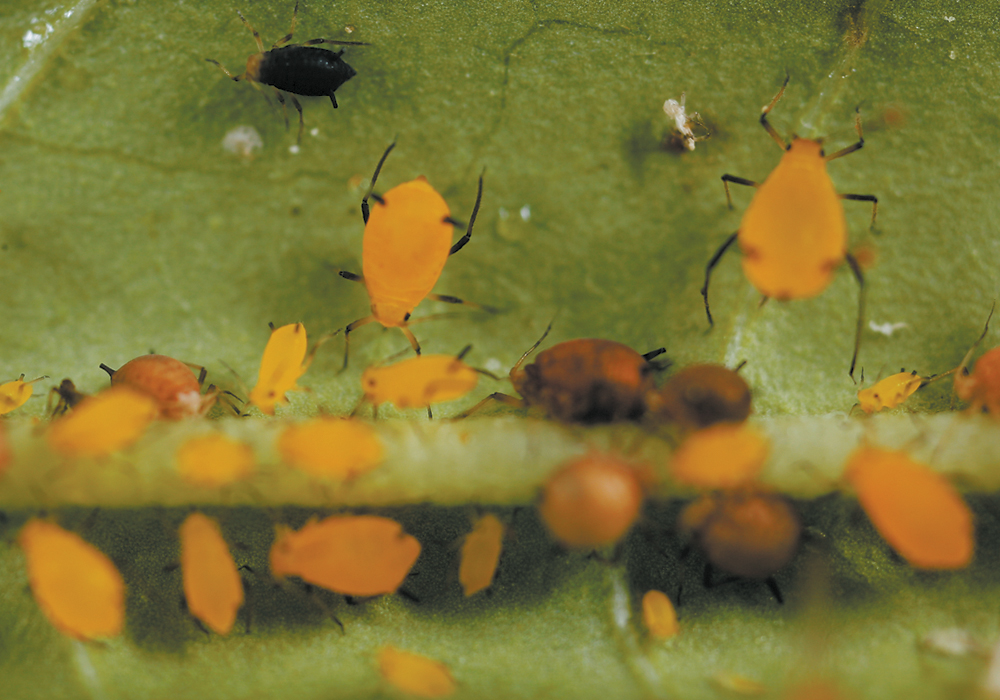App helps farmers determine economic threshold levels for spraying based on aphid numbers and canaryseed prices
A free smartphone app that monitors cereal aphids is being adapted to detect the pesky little critters in canaryseed.
Like wheat, barley, oats and rye, knowing if and when to spray can be difficult with canaryseed.
And just like cereals, decisions are driven by estimating aphid populations in canaryseed crops, which can be affected by weather and natural predators.
The app considers these factors to find if aphid numbers will rise to economic threshold levels, in which it becomes necessary to spray.
Tyler Wist from Agriculture Canada in Saskatoon has been studying aphids since 2012 and originally helped develop the app specifically for cereal aphids.
Read Also

Farming Smarter receives financial boost from Alberta government for potato research
Farming Smarter near Lethbridge got a boost to its research equipment, thanks to the Alberta government’s increase in funding for research associations.
The research scientist of field crop entomology presented his latest findings at an agronomic update during Crop Production Week in Saskatoon last month.
Between 2017 and 2019, Wist and Agriculture Canada agronomist Bill May conducted field studies to determine economic thresholds for aphid infestations in canaryseed in Saskatchewan.
Canaryseed can be attacked by the bird cherry-oat aphid, which is very dark green, and the light-green grain aphid during the early heading stage.
Both species have not been abundant enough to cause economic losses, but southerly winds in the spring allow for early infestations from the United States, which has the potential to cause crop injury.
“Currently, we’ve seen aphid infestation that hasn’t caused significant amounts of damage. That doesn’t mean aphids can’t cause a significant amount of damage. We just haven’t had the right combination of environmental conditions and the development of canaryseed damage,” said May.
“We’re not sure what level in the field we need to be at to measure economic damage.”
Aphids often hide in the leaf sheaf of the flag leaf and in the panicle of the plant.
The florets need to be pulled back to see into the interior of the panicle to determine infestation levels.
Earlier agronomic research had nominal threshold levels for insecticide application set at 25 aphids or more for every other head, which Wist said confused matters.
About halfway through the project they determined 10 aphids per head was a realistic and straightforward working number.
“What’s important with a valid economic threshold is this is where the aphids cause enough yield that the money that they’re costing you is offset by the cost of the spray. So it’s kind of a balancing point right there and so we needed that to put into the cereal aphid manager app,” he said.
The economic threshold for insecticide application is also affected by canaryseed price, with the threshold number being low when the canaryseed price is high.
If aphids exceed population density, insecticide should be applied at early heading, around mid- to late-July.
Aphids do little economic damage by the soft dough stage of the seed, so spraying after that is not recommended.
“The caveat to canaryseed is the main heads are not the only ones maturing. If we’ve had a significant amount of rain, we’ll have another flush of tillers that need to be watched for aphids,” said May.
After completing the recommended path in the shape of a W, which includes at least five steps, the app will provide a prediction to spray, not spray, or when to sample again.
The collected data sampled along with the recommendation is stored on the user’s device to keep track of the field’s aphid population over the growing season.
“The app takes you out in the field, gives you a scouting pattern, makes you follow it, and you get the number of aphids per tiller on average. Then it compares that against the future population. So it actually runs a little calculation in the background and it tries to predict how your aphid population is going to increase,” said Wist.
“So if your aphid population increases beyond that economic threshold, the app will recommend that you deal with those aphids right now.”
He said the app has the ability to work in a dynamic action threshold from data researchers have collected since 2012.
This means the app includes a photo guide of the aphid species found in Western Canada as well as images of its natural enemies including parasitic wasps, green lacewing larvae and adult and larval ladybugs.
“If you’ve got lots of lady beetles, they’ll actually negatively impact your aphid population and bring them down. It might keep the population from hitting that economic threshold,” Wist said.
“Right now we can’t recommend that guys spray for aphids unless they’ve got significantly more than 15 per head. We think that might be the threshold but we don’t know yet,” said May.


















